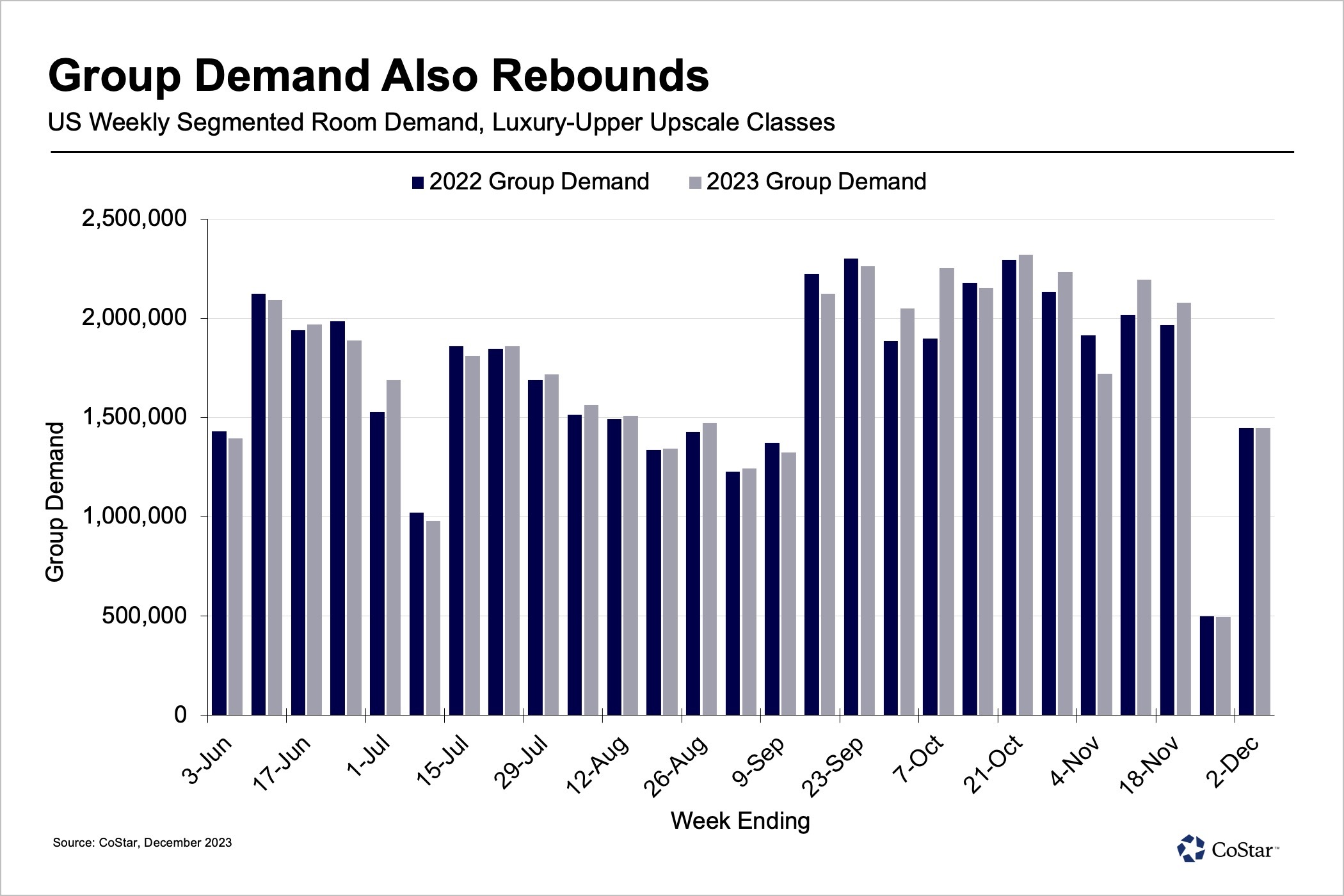Events, festivals and holiday activities are the main drivers of travel and hotel performance around the world as 2023 enters its final weeks.
The timing of recurring events is also having an impact, as in the case of Art Basel, a contemporary art festival in Miami that for its 20th anniversary last year drew an estimated 76,000 people to the Miami Beach Convention Center. The event in 2022 ran from Nov. 28 to Dec. 4, but this year it shifted a week later, resulting in some tough comparisons for Miami that even dragged down total U.S. hotel performance.
Still, college football championship games provided a boost to hotels in other markets across the U.S., including Indianapolis, which hosted the Big 10 Championship and claimed the second highest Saturday occupancy in the nation after New York City.
Concerts and sporting events also buoyed hotels across Europe in the week of Nov. 27; and in Dubai, COP 28, the United Nations Climate Change Conference, was a driver of performance.
US Performance
Moving past Thanksgiving, U.S. hotel occupancy reached 54.2%, an increase of 4.8 percentage points compared to the prior week but down 0.9 percentage points versus last year. Average daily rate increased 0.8% year over year, which was insufficient to grow RevPAR.

The calendar shift of Art Basel resulted in a 50.6% RevPAR decrease for the Miami market. Excluding Miami, U.S. RevPAR would have increased 1.2%, which is in line with 2017, a year with the same calendar makeup as 2023.
Despite the negative impact from Maimi, weekdays showed better performance with RevPAR increasing 2.7%, driven by the same gain in ADR as occupancy was flat to last year. The weekend and shoulder days (Sunday and Thursday) showed declines in both occupancy and ADR, resulting in RevPAR declines of 3.3% and 3.1%, respectively.

Weekday performance in the top 25 markets was similar to the industry overall. However, a 5.2% decrease in top-25 weekend RevPAR was much worse than in the remaining markets due to the impact of Miami. ADR was down 0.2% in the top 25 markets, but up 1.9% on average in all other markets. Excluding Miami, top 25 market ADR increased 3.4%, and RevPAR topped 2.4%, well ahead of all other markets.
New York City and Las Vegas posted the highest occupancy across the top 25 markets, contributing to RevPAR increases of 17.2% and 12.2%, respectively. Hotels in these markets also had the highest weekday occupancy in the U.S.
New York City hotel occupancy of 90.3% topped 2019 levels, as it has 26 times this year. Supply declines are contributing to the occupancy gains. Since the beginning of June, hotel room supply has decreased by more than 3%, with most of the declines driven by hotels closed for the housing of migrants. Demand is still lower than what it was in 2019, but ADR growth is soaring, with most of the growth coming from the smaller, non-traditional submarkets in the city such as JFK and LaGuardia, which have a limited amount of supply but have experienced a sharp decrease in inventory.

Indianapolis, host of the Big 10 Championship, posted occupancy of 90.3% and a 13% year-over-year increase in RevPAR on the Saturday of the game.
Global Performance
Global occupancy, excluding the U.S., reached 66.8%, up 5.5 percentage points year over year and down 1.9 percentage points from the previous week. ADR reached $131, up 7.3% year over year, and RevPAR was up 17% to $87.

Performance in the top 10 countries based on total supply was slightly above the global average with occupancy of 67.4%, up 7.4 percentage points year over year and down 1.7 percentage points from the previous week. The group was led by strong gains in both occupancy and ADR from countries outside of Asia, mainly Germany and Spain.
Large football matches took place Tuesday and Wednesday throughout Europe for the group stages of the Champions league, which includes the biggest European football clubs, drawing international crowds. Spain, Barcelona, Madrid and Seville each hosted a match which boosted the country’s hotel performance, with occupancy up 6.7 percentage points and ADR up 12% year over year. The United Kingdom also hosted matches throughout the country and returned the highest occupancy for the top 10 countries at 79.8%, up 1.1 percentage points year over year. Occupancy for Germany was up 8.4 percentage points to 74.6%, and ADR climbed 13.1% year over year. Along with the European football matches, Germany’s capital, Berlin, hosted back-to-back nights of Madonna’s European tour, which also boosted the city’s performance.

Outside of the top 10, COP 28 kicked off in Dubai. Three days into the event, United Arab Emirates ADR was up 68% year over year to $332 with an occupancy gain of 2.8 percentage points.
Isaac Collazo is vice president of analytics at STR. Chris Klauda is senior director of market insights at STR. William Anns is a research analyst at STR.
This article represents an interpretation of data collected by CoStar's hospitality analytics firm, STR. Please feel free to contact an editor with any questions or concerns. For more analysis of STR data, visit the data insights blog on STR.com.
